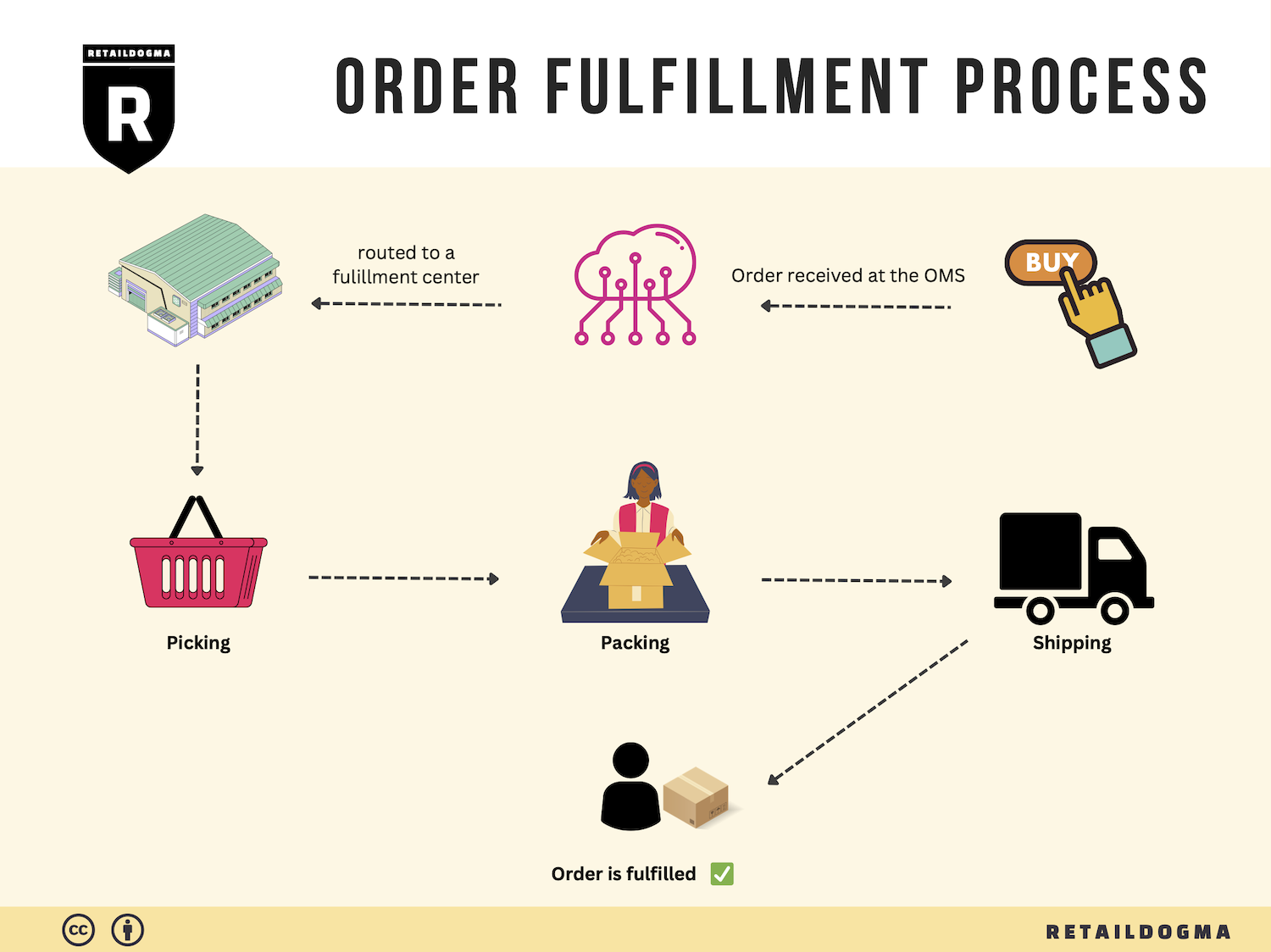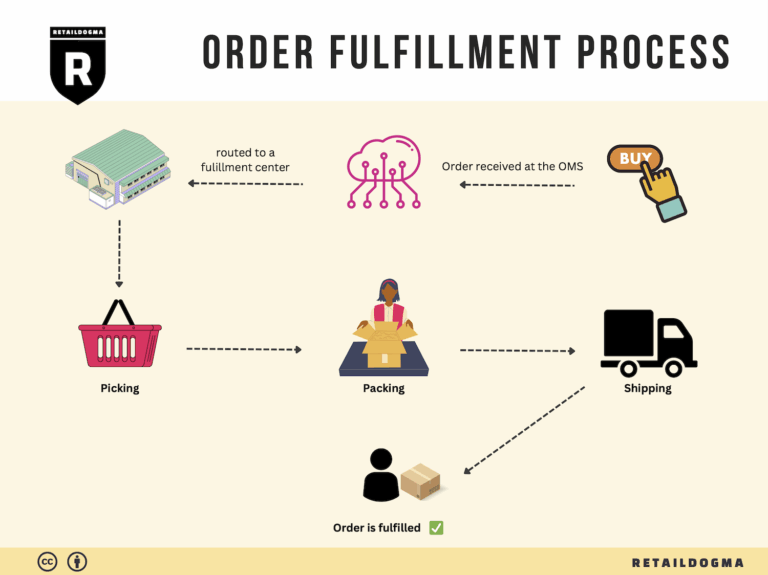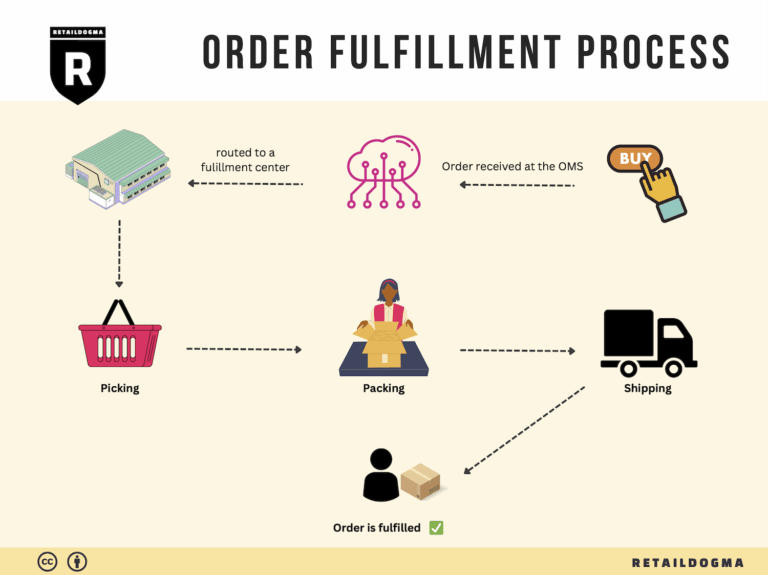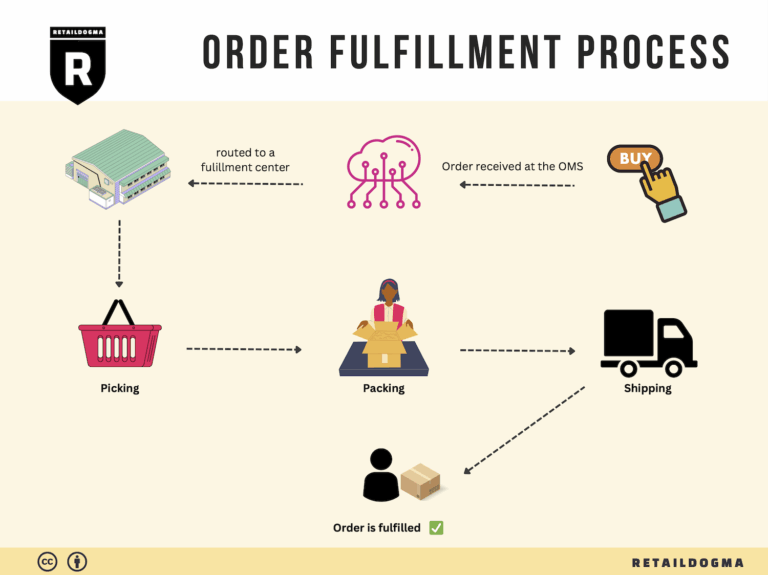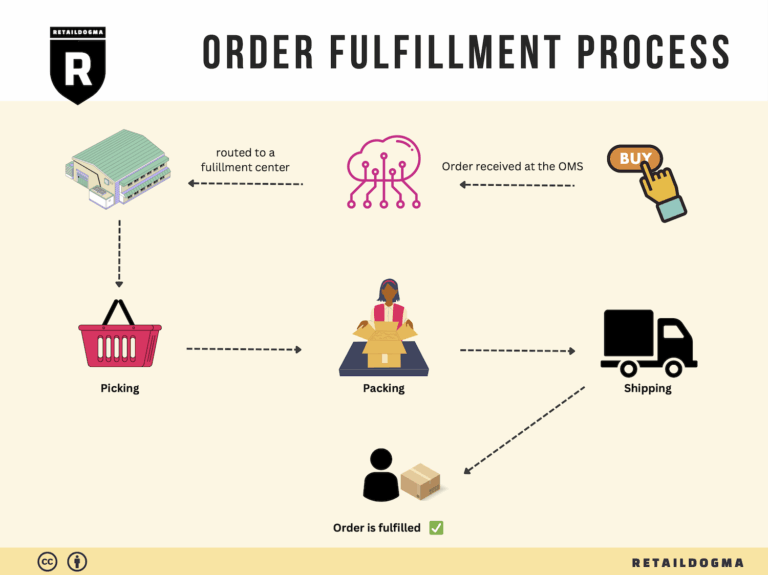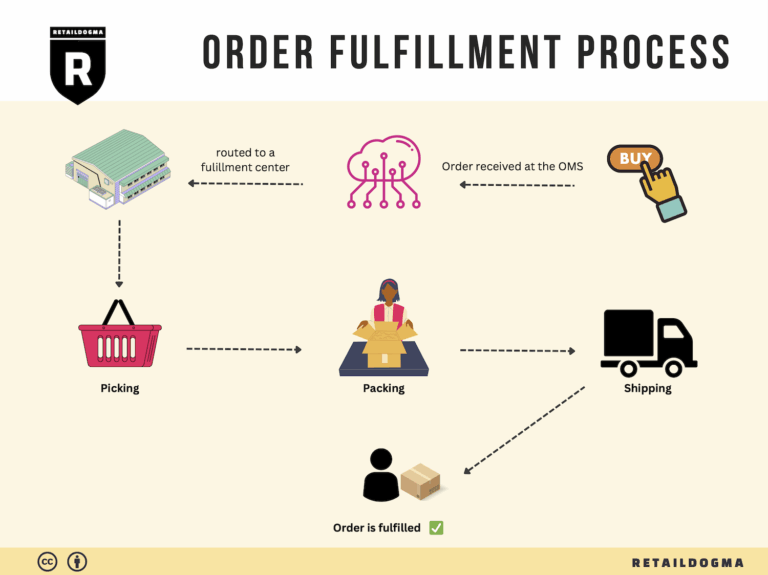How Order Fulfillment Works: A Step-by-Step Guide for Businesses
What is E-commerce Fulfillment? An Introduction for Growing Businesses
Understanding E-commerce Fulfillment: A Key to Scaling Your Business
As an e-commerce business owner, you’re likely all too familiar with the demands of packing and shipping orders. The excitement of growing sales can quickly turn into a headache when faced with the logistical challenges of fulfilling those orders efficiently. Whether you’re managing a small home-based business or scaling a larger operation, the complexity of fulfillment can become overwhelming. This is where a solid understanding of e-commerce fulfillment becomes essential.
E-commerce fulfillment is fundamentally about the process of getting a product from your inventory to your customer’s doorstep. It encompasses everything from receiving orders, picking items from storage, packing them securely, and shipping them out. For many growing businesses, the choice of fulfillment model can significantly impact efficiency, customer satisfaction, and ultimately, profitability.
In this guide, we will delve into the various fulfillment models available to you, including Third-Party Logistics (3PL) and Fulfillment by Amazon (FBA). Each model has its own set of advantages and challenges, and understanding these can help you align your fulfillment strategy with your business goals.
We will also explore the core services that fulfillment partners typically offer. These services include order processing, inventory management, custom packaging, and returns management. Knowing what to expect from a fulfillment partner will enable you to make informed decisions when selecting the right one for your business.
Moreover, we will discuss how to choose a fulfillment partner that aligns with your unique needs. Factors such as scalability, technology integration, and cost-effectiveness are crucial in this decision-making process. We will also provide insights into pricing structures, helping you understand how to budget for fulfillment services without compromising on quality.
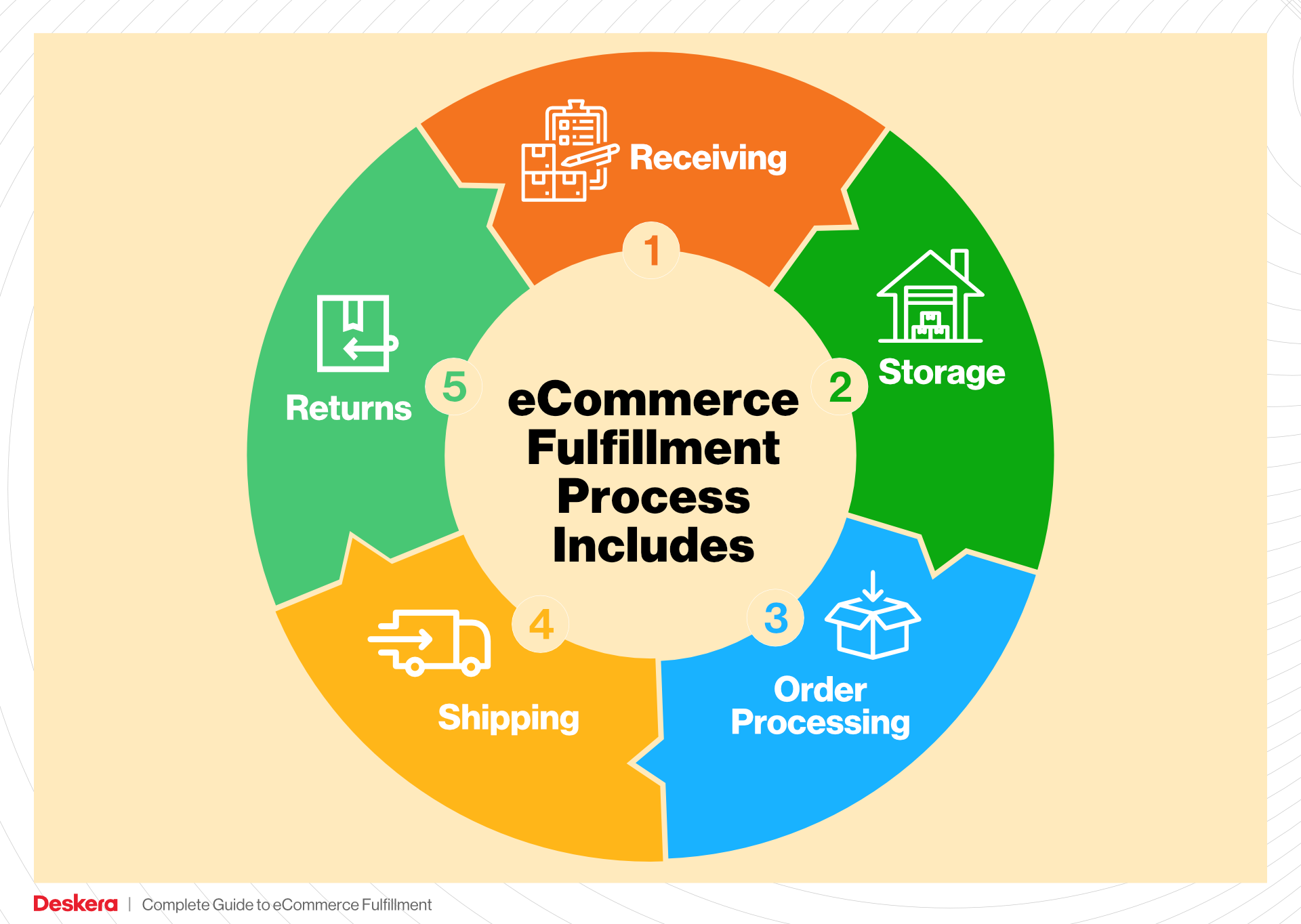
Ultimately, this guide aims to empower you with the knowledge needed to make smart decisions about your logistics. By understanding the intricacies of e-commerce fulfillment, you can streamline your operations, enhance customer satisfaction, and position your business for sustainable growth. Let’s embark on this journey to mastering e-commerce fulfillment together!
What You’ll Learn In This Guide
- What is E-commerce Fulfillment? An Introduction for Growing Businesses
- The Order Fulfillment Process: From ‘Buy’ Button to Customer’s Door
- Comparing Fulfillment Models: In-House vs. 3PL vs. Dropshipping
- A Deep Dive into Amazon FBA: Pros, Cons, and Who It’s For
- Core Services Offered by Fulfillment Centers
- How to Choose a Fulfillment Partner: A 6-Point Checklist
- Understanding Fulfillment Pricing: A Breakdown of Common Fees
- Frequently Asked Questions (FAQs) about Fulfillment
- Conclusion: Is Outsourcing Fulfillment the Right Move for Your Business?
- Important Disclaimer
The Order Fulfillment Process: From ‘Buy’ Button to Customer’s Door
1. Receiving Inventory
The order fulfillment process begins with the Receiving Inventory stage, where products arrive at the fulfillment center. This is a critical step, as it sets the foundation for the entire fulfillment operation. Upon arrival, items are verified against purchase orders to ensure accuracy in quantity and quality. This process often involves using Stock Keeping Units (SKUs), unique identifiers assigned to each product, which help streamline inventory management.
Proper receiving practices are essential to minimize discrepancies and ensure that inventory levels are accurately reflected in the system. An efficient receiving process helps prevent stockouts and overstock situations, which can lead to lost sales or increased holding costs. Businesses should implement a system for checking and recording incoming inventory, ensuring that all products are accounted for and correctly labeled.
2. Warehouse Storage
Once inventory is received, the next step is Warehouse Storage. This involves organizing products in the warehouse for easy access and efficient retrieval. Effective storage solutions are vital for optimizing space and improving order fulfillment speed. Products are typically categorized by type, size, or demand frequency, allowing for quicker identification and retrieval.
Key to this stage is the use of bin locations—specific spots designated for particular items. This organization reduces the time spent searching for products when orders come in. Moreover, implementing inventory management software can enhance visibility and tracking of stock levels, enabling businesses to respond quickly to fluctuations in demand. Proper warehouse storage not only improves operational efficiency but also ensures that products are stored safely, reducing the risk of damage.
3. Order Picking
The Order Picking stage is where the fulfillment process gains momentum, as it involves selecting items from their designated storage locations to fulfill customer orders. This step is crucial because it directly impacts order accuracy and delivery speed. To facilitate picking, fulfillment centers often use pick lists, which detail the items and quantities needed for each order.
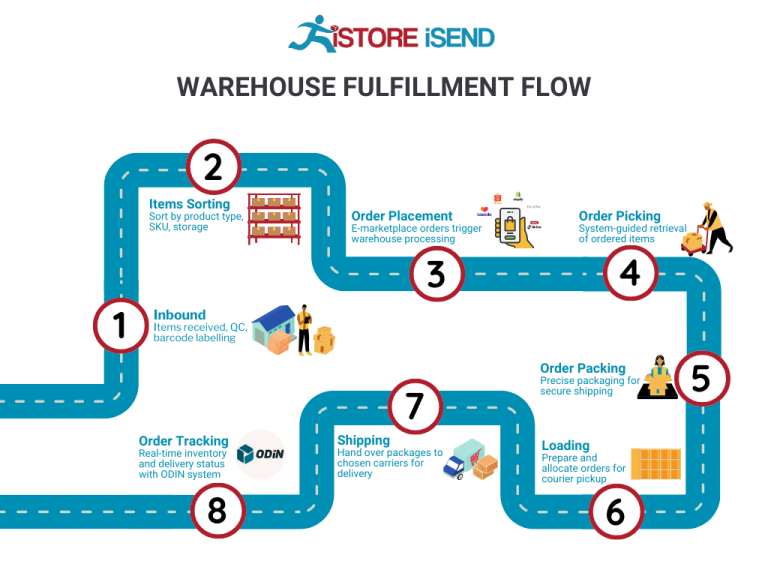
Efficient picking strategies, such as zone picking or wave picking, can significantly enhance productivity. Zone picking divides the warehouse into specific areas for different products, while wave picking batches similar orders together for simultaneous processing. By optimizing the picking process, businesses can reduce the time taken to fulfill orders, leading to increased customer satisfaction and repeat purchases.
4. Order Packing
Following the picking stage is Order Packing, where selected items are prepared for shipment. This step is vital for ensuring that products are protected during transit and arrive at the customer’s door in perfect condition. During packing, items are often placed in boxes or envelopes with appropriate packing materials to prevent damage.
A key consideration during packing is the use of packaging optimization techniques. This involves selecting the right box size and packing materials to minimize shipping costs while ensuring product safety. Additionally, including packing slips and return instructions can enhance the customer experience. Proper packing not only safeguards products but also reflects the brand’s commitment to quality and customer service.
5. Shipping & Delivery
The final step in the order fulfillment process is Shipping & Delivery, where packed orders are handed over to carriers for transport to customers. This stage is crucial, as timely delivery can significantly influence customer satisfaction and retention. Businesses must choose reliable shipping partners and negotiate favorable shipping rates to maintain cost-effectiveness.
Effective shipping practices include tracking systems that provide real-time updates to customers regarding their order status. This transparency builds trust and keeps customers informed throughout the delivery process. Additionally, offering multiple shipping options—such as standard and expedited delivery—can cater to varying customer needs and enhance overall satisfaction. The shipping and delivery stage is the culmination of the entire fulfillment process, making it essential for businesses to execute it flawlessly to maintain a positive brand reputation.
By understanding and optimizing each of these five steps, e-commerce businesses can enhance their order fulfillment processes, improve customer satisfaction, and ultimately drive growth.
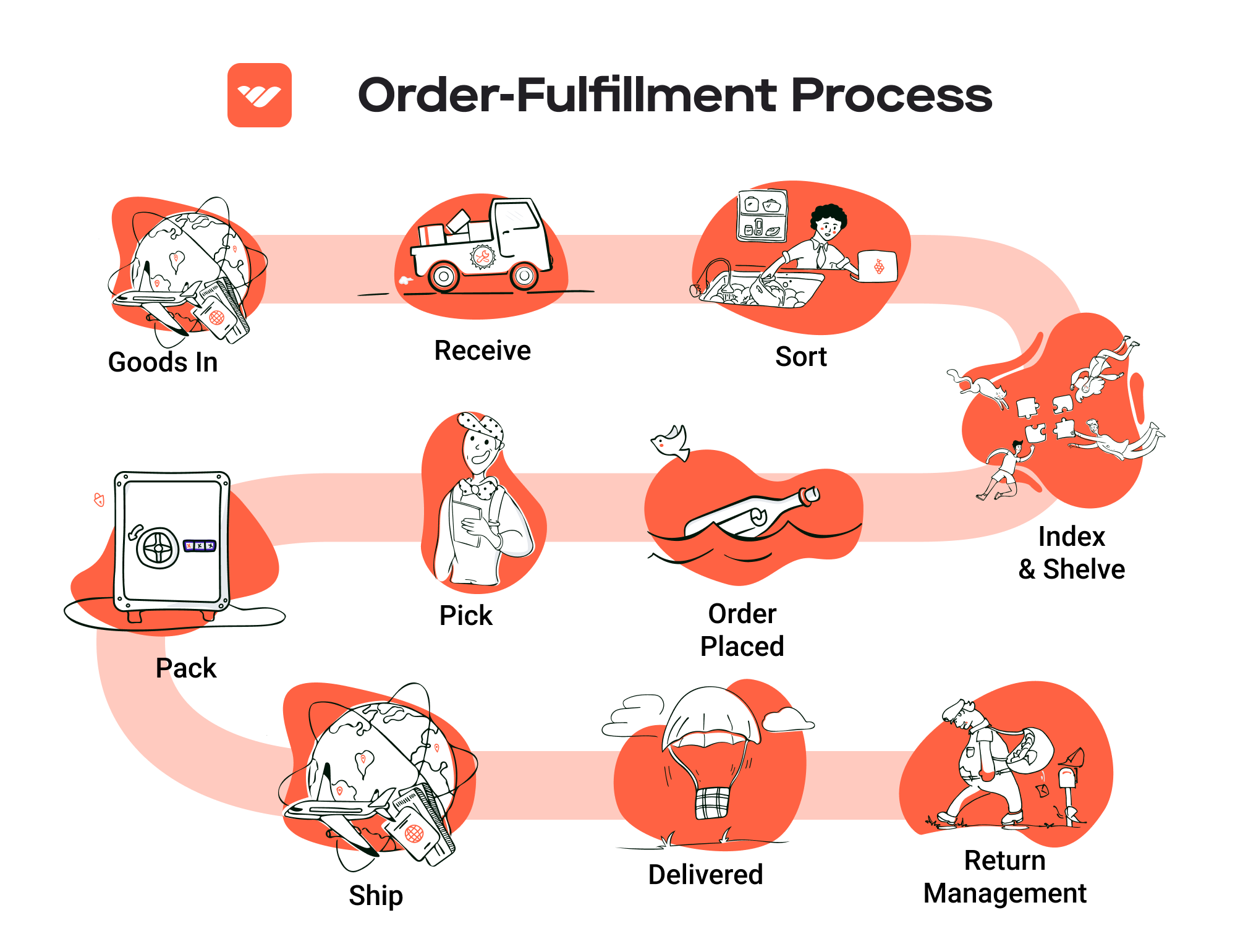
Comparing Fulfillment Models: In-House vs. 3PL vs. Dropshipping
Fulfillment Model Comparison
| Model | Who Handles Inventory | Best For (Business Stage) | Key Advantage | Key Disadvantage |
|---|---|---|---|---|
| In-House Fulfillment | The business itself | Established businesses with stable demand | Full control over inventory and processes | High overhead costs and resource requirements |
| Third-Party Logistics (3PL) | 3PL provider | Growing businesses and startups | Scalable solutions with reduced overhead | Less control over inventory and fulfillment processes |
| Dropshipping | Supplier or manufacturer | New businesses and entrepreneurs | Low startup costs with minimal inventory risk | Lower profit margins and reliance on suppliers |
In-House Fulfillment
In-house fulfillment refers to when a business manages its inventory and order fulfillment processes internally. This model is typically adopted by established businesses that have a stable and predictable demand for their products. Companies that opt for in-house fulfillment have complete control over their inventory, allowing them to maintain quality standards and streamline their processes to meet customer expectations. This control can be particularly advantageous when dealing with high-value products or items that require special handling. However, the in-house model comes with significant overhead costs, including warehousing, staffing, and technology investments. Additionally, managing logistics can divert focus from core business activities, potentially stunting growth if not handled efficiently.
Third-Party Logistics (3PL)
Third-party logistics (3PL) involves outsourcing fulfillment operations to a specialized service provider that handles inventory management, warehousing, and shipping. This model is ideal for growing businesses and startups that may not yet have the resources to manage fulfillment in-house. Partnering with a 3PL provider, such as the Amazon Fulfillment Center in Houston, allows businesses to scale operations without the burden of significant capital investment in warehousing and logistics infrastructure. Key advantages of 3PL include access to advanced technology for inventory management and real-time data analytics, which can enhance operational efficiency and customer satisfaction. However, businesses may face challenges in terms of control over the fulfillment process and potential communication gaps with the 3PL provider, which can impact delivery times and customer experience.
Dropshipping
Dropshipping is a fulfillment model where the retailer does not keep the products it sells in stock. Instead, when a retailer sells a product, it purchases the item from a third party—usually a wholesaler or manufacturer—who then ships it directly to the customer. This model is particularly appealing to new businesses and entrepreneurs due to its low startup costs and minimal inventory risk. Retailers can offer a wide range of products without the need for significant upfront investment in inventory or warehousing. However, dropshipping also comes with its own set of challenges, such as lower profit margins and a heavy reliance on suppliers for quality control and timely delivery. Additionally, since retailers have less control over the fulfillment process, they may encounter difficulties managing customer expectations and resolving issues related to shipping delays or product quality.
Conclusion
Selecting the right fulfillment model is crucial for e-commerce businesses as they scale operations. Each model—In-House Fulfillment, 3PL, and Dropshipping—offers unique advantages and challenges that cater to different business stages and operational capabilities. Understanding these distinctions can help business owners make informed decisions that align with their growth strategies and customer service goals. As businesses evolve, they may also choose to switch between these models to adapt to changing market conditions, customer demands, and internal resources.
A Deep Dive into Amazon FBA: Pros, Cons, and Who It’s For
What is Fulfillment by Amazon (FBA)?
Fulfillment by Amazon (FBA) is a service offered by Amazon that allows sellers to store their products in Amazon’s fulfillment centers. Amazon takes care of storage, packaging, shipping, and customer service for these products. When a customer orders a product, Amazon handles the entire process, from picking the item from the warehouse to packing it and shipping it directly to the customer. This service is designed to simplify logistics for sellers, enabling them to focus on growing their business rather than managing the complexities of order fulfillment.
How FBA Works
-
Setup: Sellers create an Amazon seller account and enroll in the FBA program. They then prepare their products according to Amazon’s guidelines, which include labeling and packaging requirements.
-
Shipping to Amazon: Once products are ready, sellers ship them to Amazon’s fulfillment centers. Amazon has numerous fulfillment centers across the United States and globally, allowing for efficient inventory management and shipping.
-
Storage: Products are stored in Amazon’s warehouses. Sellers can monitor inventory levels through their Amazon seller dashboard.
-
Order Processing: When a customer places an order, Amazon picks the item from the warehouse, packs it, and ships it. This process is typically very efficient due to Amazon’s advanced logistics systems.
-
Customer Service: Amazon also handles all customer inquiries and returns related to FBA orders, freeing sellers from these responsibilities.
Pros of FBA
1. Prime Eligibility
One of the most significant advantages of using FBA is that it makes products eligible for Amazon Prime. This membership program offers customers fast, free shipping options, which can significantly enhance the visibility and attractiveness of products. Being part of Prime can lead to increased sales, as many customers prefer to shop for Prime-eligible products.
2. Customer Trust
Amazon is a trusted name in e-commerce. By using FBA, sellers benefit from Amazon’s reputation for reliability and customer service. Customers are more likely to purchase items fulfilled by Amazon due to the assurance of quality service, fast shipping, and easy returns.
3. Multi-Channel Fulfillment
FBA is not limited to just Amazon sales. Sellers can also use FBA to fulfill orders from other sales channels, such as their own websites or other marketplaces. This multi-channel fulfillment capability allows businesses to streamline their operations and maintain consistent inventory across different platforms.
4. Reduced Operational Burden
FBA allows sellers to delegate storage, packing, and shipping tasks to Amazon. This delegation reduces the time and resources spent on logistics, allowing sellers to focus on other critical aspects of their business, such as marketing and product development.
5. Advanced Logistics
Amazon’s sophisticated logistics network ensures that products are shipped quickly and efficiently. With real-time inventory tracking and analytics, sellers can gain insights into sales patterns and customer preferences, enabling them to make informed business decisions.
Cons of FBA
1. High Fees
While FBA offers many benefits, it comes with associated costs. Sellers are charged for storage space and fulfillment services. These fees can add up, especially for small or low-margin products. Sellers need to carefully calculate these costs to determine if FBA is financially viable for their business.
2. Strict Inventory Rules
Amazon enforces strict inventory management rules. Sellers must ensure that their inventory levels are optimized to avoid long-term storage fees and stockouts. Additionally, products that don’t sell quickly can incur additional charges, creating pressure to manage stock effectively.
3. Commingling Risks
FBA operates on a commingling model, which means that products from different sellers may be stored together. While this can enhance efficiency, it also poses risks. If a customer receives a defective or damaged product, it can be challenging to trace it back to the original seller, potentially harming their reputation.
4. Loss of Control
By relying on Amazon for fulfillment, sellers may feel they have less control over their logistics. Issues such as shipping delays or customer service problems can reflect poorly on the seller, even if they are not directly responsible for the issues.
5. Limited Branding Opportunities
FBA packages often carry Amazon branding, which can limit sellers’ ability to establish their own brand identity. This lack of branding can be a disadvantage for businesses looking to build a loyal customer base.
Who is FBA Best For?
FBA is particularly beneficial for sellers who:
- Have High Sales Volume: Businesses that sell large quantities of products can benefit from the economies of scale offered by FBA.
- Sell in Competitive Categories: Products that are part of highly competitive categories may gain an edge with Prime eligibility and Amazon’s customer service.
- Lack Logistics Expertise: Sellers who do not have the resources or knowledge to manage fulfillment and logistics effectively can leverage FBA to streamline their operations.
- Are Looking to Scale: Businesses aiming to grow quickly can utilize FBA’s infrastructure to handle increased order volumes without needing to invest heavily in their logistics capabilities.
- Sell Across Multiple Channels: Those looking to sell on Amazon as well as other platforms can benefit from FBA’s multi-channel fulfillment capabilities.
In conclusion, while FBA offers numerous advantages that can help scale an e-commerce business, it is essential to weigh these benefits against the associated costs and potential drawbacks. Each business should assess its unique situation to determine whether FBA aligns with its operational goals and financial strategy.
Core Services Offered by Fulfillment Centers
Inventory Management & Warehousing
Effective inventory management and warehousing are foundational to successful e-commerce operations. Fulfillment centers provide dedicated storage space for your products, allowing businesses to scale without the need for significant upfront investment in warehouse facilities. These centers utilize advanced inventory management systems that track stock levels in real-time, alerting you when reordering is necessary.
The benefits of robust inventory management include reduced overhead costs and improved cash flow. By outsourcing warehousing, businesses can focus on their core competencies, such as marketing and product development, rather than the logistical complexities of managing stock. Additionally, accurate inventory tracking minimizes the risk of stockouts or overstock situations, ensuring that your customers receive their orders promptly and enhancing overall satisfaction.
Pick and Pack Services
Pick and pack services are crucial for the order fulfillment process. This service involves the selection of items from inventory (picking) and then preparing them for shipment (packing). Fulfillment centers employ efficient workflows that streamline this process, often using advanced technology to enhance accuracy and speed.
The primary advantage of pick and pack services is the efficiency they bring to order fulfillment. By outsourcing this function, e-commerce businesses can handle varying order volumes without needing to employ additional staff or invest in training. This scalability is particularly important during peak seasons or promotional events. Moreover, meticulous packing ensures products arrive safely, which not only reduces return rates but also bolsters customer trust and brand loyalty.
Kitting and Assembly
Kitting and assembly services involve grouping individual items into ready-to-ship sets or configuring products according to specific customer requests. This is particularly beneficial for businesses that sell products requiring assembly or those offering bundled products, such as gift sets or promotional packs.
The key benefit of kitting and assembly services lies in the enhanced customer experience they provide. By delivering items in a pre-assembled format, businesses can save their customers time and effort, making their products more appealing. Additionally, this service can reduce shipping costs by consolidating multiple items into one shipment, thus optimizing logistics. For businesses looking to differentiate themselves in a competitive market, kitting can also serve as a value-added service that enhances product offerings and encourages upsells.
Returns Management (Reverse Logistics)
Returns management, often referred to as reverse logistics, is a critical service offered by fulfillment centers. This involves handling product returns from customers, processing them efficiently, and determining whether items can be restocked, refurbished, or need to be disposed of. Effective returns management systems are essential, especially in the e-commerce space where return rates can be significantly higher than traditional retail.
The benefits of a well-implemented returns management process are multifaceted. Firstly, it enhances customer satisfaction by providing a hassle-free return experience, which is crucial for fostering loyalty and repeat business. Secondly, efficient processing of returns can help recover value from returned items, either through resale or refurbishment, thereby minimizing losses. Finally, having a clear and effective returns policy, managed by a fulfillment center, can serve as a competitive advantage, reassuring customers that they can shop confidently knowing that returns are easy to handle.
Conclusion
Partnering with a fulfillment center that offers these core services can significantly enhance your e-commerce operations. By leveraging their expertise in inventory management, pick and pack services, kitting and assembly, and returns management, businesses can streamline their logistics, reduce operational burdens, and ultimately focus on growth and customer satisfaction. As you consider your options, evaluate how these services align with your business needs and objectives, ensuring a scalable and efficient fulfillment strategy that supports your long-term success.
How to Choose a Fulfillment Partner: A 6-Point Checklist
Location & Warehouse Network
Importance:
The geographical location of your fulfillment partner’s warehouses can significantly impact your shipping times and costs. A partner with multiple strategically located warehouses can facilitate faster delivery to your customers, which is crucial for maintaining a competitive edge in e-commerce.
Questions to Ask:
– Where are your warehouses located? How do these locations align with my target market?
– Do you have the ability to expand your warehouse network if my business grows?
– How do you handle inventory management across multiple locations?
Technology & Integrations
Importance:
In today’s digital landscape, a fulfillment partner’s technology capabilities are essential. A partner that offers robust technology solutions can automate processes, provide real-time tracking, and integrate seamlessly with your e-commerce platforms, improving overall efficiency.
Questions to Ask:
– What technology platforms do you use for inventory management, order processing, and shipping?
– Can your systems integrate with my existing e-commerce platforms (e.g., Shopify, Amazon, WooCommerce)?
– Do you offer real-time data analytics and reporting? How can I access this information?
Specializations (e.g., cold storage, oversized items)
Importance:
Different businesses have unique product requirements. If your products require special handling, such as temperature control for perishables or specific packaging for oversized items, it’s vital to choose a fulfillment partner that specializes in these areas.
Questions to Ask:
– What special services do you offer (e.g., cold storage, fragile item handling)?
– Can you accommodate the specific needs of my products?
– Do you have experience working with businesses in my industry?
Scalability & Capacity
Importance:
Your fulfillment partner should be able to grow with your business. Whether you experience seasonal spikes in demand or long-term growth, it’s important that your partner can accommodate fluctuating volumes without compromising service quality.
Questions to Ask:
– What is your current capacity, and how do you handle peak seasons?
– Can you provide examples of how you’ve scaled operations for other clients?
– What processes do you have in place to ensure quality remains high during busy periods?
Pricing and Contracts
Importance:
Understanding the pricing structure and contract terms is essential for budgeting and financial planning. Transparent pricing can help you avoid unexpected costs and ensure your partnership remains profitable.
Questions to Ask:
– What is your pricing model (e.g., per order, storage fees, pick and pack fees)?
– Are there any hidden fees I should be aware of?
– What are the terms of the contract? Is there flexibility for renegotiation as my business changes?
Customer Support & Reviews
Importance:
Effective customer support is critical for resolving issues quickly and maintaining operational efficiency. Additionally, researching customer reviews can provide insights into a partner’s reliability and service quality.
Questions to Ask:
– What support channels do you offer (e.g., phone, email, chat)?
– How quickly can I expect a response to my inquiries?
– Can you provide references or testimonials from current or past clients? What do they say about your service?
Conclusion
Choosing the right fulfillment partner is a strategic decision that can significantly influence your e-commerce business’s success. By utilizing this checklist, you can evaluate potential partners comprehensively, ensuring they align with your operational needs and growth ambitions. A thorough assessment based on these criteria will help you find a 3PL partner that not only meets your current requirements but also supports your long-term goals.
Understanding Fulfillment Pricing: A Breakdown of Common Fees
Initial Setup Fees
When partnering with a fulfillment center, businesses may incur initial setup fees. These charges typically cover the costs associated with onboarding your products into the fulfillment system. This may involve creating an account, setting up storage locations, and integrating your inventory management systems with the warehouse’s technology.
The calculation of initial setup fees can vary significantly based on the complexity of your needs. For instance, if you require special handling, labeling, or custom packaging, expect higher costs. Generally, these fees can range from a few hundred to several thousand dollars, depending on the size of your operation and the specific services required.
Receiving Fees
Receiving fees are charged when your products are delivered to the fulfillment center. These fees cover the labor and resources needed to unload, inspect, and organize incoming inventory.
The calculation of receiving fees is often based on the volume of products received, typically measured by units or weight. For example, a fulfillment center may charge a flat rate per pallet or per item, with costs typically ranging from $10 to $30 per pallet, depending on the complexity of the receiving process. If your products require detailed inspection or special handling upon arrival, this can lead to higher fees.
Storage Fees (per pallet/bin)
Once your products are in the fulfillment center, you will incur storage fees based on the space your inventory occupies. These fees are crucial for managing the costs of holding stock and can vary depending on the size of the items being stored.
Storage fees are typically calculated on a per pallet or per bin basis, with rates varying based on the type of storage (standard or climate-controlled). For example, businesses might see storage fees ranging from $15 to $50 per pallet per month. It’s important to note that some fulfillment centers may offer tiered pricing, where the cost per pallet decreases as the volume of stored pallets increases.
Pick & Pack Fees (per item/order)
Pick and pack fees are incurred each time an order is processed and shipped. This fee encompasses the costs of picking items from storage, packing them securely, and preparing them for shipment.
The calculation of pick and pack fees can vary widely based on several factors, including the number of items per order, the complexity of packing requirements, and the type of packaging materials used. A typical structure may involve a base fee for picking the first item, plus an additional fee for each subsequent item, such as $1.50 for the first item and $0.50 for each additional item. Therefore, a three-item order could incur a total pick and pack fee of $2.50.
Shipping Fees
Shipping fees are one of the most significant costs associated with order fulfillment. These fees cover the actual transportation of goods from the fulfillment center to your customers. Shipping costs can vary based on several factors, including the destination, the weight and dimensions of the package, and the shipping method selected (standard, expedited, etc.).
Typically, fulfillment centers negotiate shipping rates with carriers and can offer discounted rates based on the volume of shipments. Businesses should expect to pay anywhere from $5 to $20 for domestic shipping, depending on the package size and delivery speed. It’s advisable to compare shipping options and consider the trade-offs between cost and delivery times to find the best solution for your business.
Tips for Getting an Accurate Quote
-
Provide Detailed Information: When seeking quotes, be as detailed as possible about your product types, order volumes, and any special handling requirements. This will help fulfillment centers provide a more accurate estimate.
-
Ask About Hidden Fees: Inquire about any additional charges that may not be included in the initial quote, such as fees for returns, restocking, or custom packaging.
-
Compare Multiple Providers: Don’t settle for the first quote. Compare pricing and services from multiple fulfillment centers to ensure you’re getting the best value for your needs.
-
Negotiate: If you’re expecting high volumes, don’t hesitate to negotiate for better rates. Many fulfillment centers are willing to offer discounts for larger commitments.
-
Review Contracts Carefully: Before signing any agreements, thoroughly review the contract for all fees and terms. Ensure you understand the pricing structure and any conditions that may affect costs in the future.
By understanding these common fees and following these tips, you can make informed decisions that help optimize your fulfillment strategy and support your business growth.
Frequently Asked Questions (FAQs) about Fulfillment
What is an Amazon Fulfillment Center?
An Amazon Fulfillment Center is a large warehouse facility where Amazon stores, picks, packs, and ships products on behalf of sellers. It plays a critical role in ensuring that customer orders are processed efficiently and delivered quickly, contributing to Amazon’s promise of fast and reliable service.
What is the difference between a warehouse and a fulfillment center?
A warehouse is primarily a storage facility where goods are kept until they are needed. In contrast, a fulfillment center is designed for processing orders. It not only stores products but also handles the logistics of picking, packing, and shipping items directly to customers. This distinction is crucial for e-commerce businesses that require efficient order processing.
What is a 3PL?
A 3PL, or Third-Party Logistics provider, is a company that offers logistics services to businesses. This includes warehousing, order fulfillment, transportation, and inventory management. By partnering with a 3PL, businesses can focus on their core operations while outsourcing their logistics needs, resulting in improved efficiency and cost savings.
How much do fulfillment services cost?
The cost of fulfillment services varies based on several factors, including the volume of orders, the types of products, storage space required, and additional services like packaging and shipping. Generally, fulfillment centers charge for storage space, order processing, and shipping fees. It’s essential for businesses to request quotes and analyze pricing structures from multiple providers to find the best fit.
What services does the Amazon Fulfillment Center in Houston offer?
The Amazon Fulfillment Center in Houston provides a range of services including inventory storage, order picking, packing, and shipping. Additionally, it supports returns management and can accommodate special handling requests. This versatility allows businesses to tailor their fulfillment strategies to meet specific needs.
How do I get my products to the Amazon Fulfillment Center in Houston?
You can send your products directly to the Amazon Fulfillment Center by coordinating with your logistics provider. If you are using a 3PL service, they can manage the entire process for you, including labeling and packaging your products to comply with Amazon’s requirements before shipment.
Can I use the Amazon Fulfillment Center for my non-Amazon sales?
Yes, you can utilize the Amazon Fulfillment Center for non-Amazon sales through the Fulfilled by Merchant (FBM) program. This allows you to leverage Amazon’s logistics capabilities while selling products on other platforms. However, ensure that you understand the specific policies and fees associated with this service.
What technology is used in Amazon Fulfillment Centers?
Amazon Fulfillment Centers employ advanced technology such as automated sorting systems, robotics, and real-time inventory management software. These technologies streamline the fulfillment process, enhance accuracy, and provide valuable data analytics to help businesses optimize their operations.
How does Amazon ensure the quality of its fulfillment services?
Amazon maintains strict quality control measures throughout the fulfillment process, including thorough inspections of incoming products, standardized packing procedures, and the use of technology to track inventory. Regular audits and performance metrics help ensure that service standards are consistently met.
What are the benefits of using an Amazon Fulfillment Center in Houston?
Utilizing the Amazon Fulfillment Center in Houston offers several advantages, including access to a vast distribution network, reduced shipping times, and cost savings on logistics. The center’s strategic location also enables businesses to reach a broader customer base efficiently, enhancing overall sales potential.
Conclusion: Is Outsourcing Fulfillment the Right Move for Your Business?
Evaluating the Benefits of Outsourcing Fulfillment
In today’s competitive e-commerce landscape, choosing to outsource fulfillment can significantly enhance your business operations. One of the primary advantages is time savings. By delegating logistics tasks to a third-party provider, you free up valuable hours that can be redirected towards strategic growth initiatives, marketing, and customer engagement. This shift allows you to focus on what you do best: growing your brand and serving your customers.
Another crucial benefit is scalability. As your business experiences fluctuations in demand, having a fulfillment partner enables you to adjust quickly without the burden of expanding or contracting your warehouse space. A robust fulfillment service can easily accommodate seasonal spikes or shifts in order volume, ensuring that your customers receive their products promptly, which in turn enhances customer satisfaction and loyalty.
Moreover, partnering with a fulfillment expert brings specialized knowledge and technology to your operations. These partners are well-versed in the latest logistics trends, compliance requirements, and inventory management systems, ensuring that your business benefits from best practices and innovative solutions. This expertise can translate into cost savings through optimized shipping routes and better inventory turnover rates.
However, the success of outsourcing fulfillment hinges on choosing the right partner. It’s essential to evaluate potential partners based on their ability to meet your unique needs, their technology capabilities, and their overall reliability.
Take Action
Now is the perfect time to audit your current shipping processes. Consider whether the resources you allocate to fulfillment could be better utilized elsewhere. Assess your operational efficiency and customer satisfaction levels. If you find gaps or areas for improvement, it may be time to explore fulfillment partnerships that align with your growth objectives. By making this strategic move, you can set your business on a path toward enhanced efficiency and success.
Important Disclaimer
⚠️ Important Disclaimer
The information in this guide is for educational purposes. Fulfillment services, pricing, and platform features change frequently. Always conduct your own due diligence and consult with providers directly before making business decisions.
